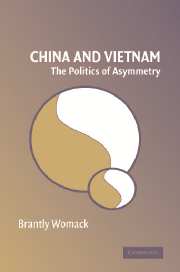Book contents
2 - The Parameters of China's External Posture
Published online by Cambridge University Press: 02 December 2009
Summary
It would be possible to write a book about relations between China and Vietnam without devoting special attention to the structure of the relationship. All information about the relationship can be fit into a narration of its history, and the current situation could be fully described in terms of “China does this” and “Vietnam does that.” There are, however, two weaknesses of commonsense description that are important for our subject. The first is that it tends to absolutize the present moment. If Mao Zedong is in power, all history leads to Mao. If Le Duan is in power, he is discussed as if he will be there forever. Without consideration of a deeper structure, the future can only be imagined as an extension of present facts. A structural analysis does not allow one to predict the future, but it can look for the context of the future that is hidden in the present and the past, and in the shape of the general situation.
The second weakness of commonsense description is specific to situations of disparity. If we do not take the different structures and contexts of China and Vietnam into account, it will appear that a particular fact or event would have the same meaning for both. I argue in this book and especially in this first part that the characteristic problem of the relationship is that it is shaped by asymmetry.
- Type
- Chapter
- Information
- China and VietnamThe Politics of Asymmetry, pp. 33 - 55Publisher: Cambridge University PressPrint publication year: 2006



